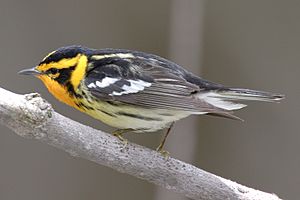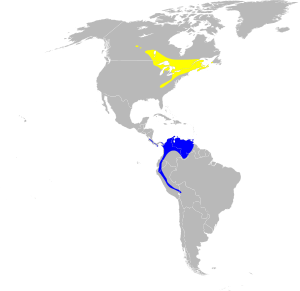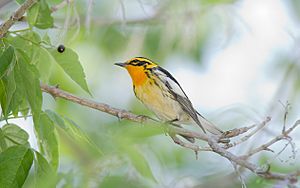Blackburnian warbler facts for kids
Quick facts for kids Blackburnian warbler |
|
|---|---|
 |
|
| In Rondeau Provincial Park, Ontario | |
| Conservation status | |
| Scientific classification | |
| Genus: |
Setophaga
|
| Species: |
fusca
|
 |
|
| Range of S. fusca Breeding range Wintering range | |
| Synonyms | |
|
Dendroica blackburniae |
|
The Blackburnian warbler (Setophaga fusca) is a small, colorful bird. It is a type of New World warbler. These birds breed in eastern North America. You can find them from southern Canada down to North Carolina. They also live near the Great Lakes region.
Blackburnian warblers are migratory birds. This means they fly long distances. They spend their winters in southern Central America and South America. Sometimes, they are seen in western Europe, but this is very rare.
Contents
What's in a Name?
The genus name Setophaga comes from Ancient Greek words. Ses means "moth" and phagos means "eating." So, it means "moth-eating." The word fusca is Latin for "brown."
This bird was named after Anna Blackburne. She was an English botanist.
Meet the Blackburnian Warbler
Blackburnian warblers are small songbirds. They are about 11 to 13 centimeters (4 to 5 inches) long. Their wingspan is about 20 to 22 cm (8 to 9 in). They weigh about 8 to 13 grams (0.3 to 0.5 ounces). That's about as much as two quarters!
Male Blackburnian warblers are very striking in summer. They have dark gray backs and white stripes on their wings. Their rumps are yellowish, and their crowns are dark brown. Their bellies are white with yellow and black streaks.
The most amazing part is their head. It has a strong pattern of yellow and black. Their throat is a bright, flaming orange! No other warbler in North America has this amazing color.
Female birds and young males have duller colors. They are like a faded version of the summer male. They don't have the super bright colors or strong head pattern. But even females are special. They have a dull-yellow stripe above their eye. This stands out against their grayish cheeks and yellow throat.
The Blackburnian warbler's song is a series of high swi notes. These notes often get higher in pitch. People describe it as zip zip zip zip zip zip zip zip or teetsa teetsa teetsa teetsa. Their call sounds like a high sip.
Scientists have studied their genes. They found that the bay-breasted warbler is their closest relative.
Where They Live and What They Eat
Blackburnian warblers are usually alone in winter. They protect their territory during breeding season. They don't mix with other bird species much, except when they are migrating.
During migration, they often join groups of other birds. These groups might include chickadees, kinglets, and nuthatches. This helps them find food together.
These birds mostly eat insects. But in winter, they will also eat berries. They usually look for insects or spiders in the tops of trees. When they are raising their young, they mostly eat Lepidoptera larvae. These are the young forms of moths and butterflies.
They can help control spruce budworms. These worms are often seen as pests. Blackburnian warblers eat them, which can help protect forests. One study in Ontario found that 98% of their diet was insects. The rest was spiders.
Home and Family Life
Blackburnian warblers like to breed in mature coniferous woodlands. These are forests with trees like pine and spruce. The main part of their breeding area is in the boreal forest of southeastern Canada. They also breed in New England and the Appalachian Mountains. They prefer mixed woodlands, especially those with spruce and hemlock trees.
In winter, they live in tropical mountain forests. These are usually found from about 600 to 2500 meters (2,000 to 8,200 feet) high. They mainly winter from Colombia to Peru.
Blackburnian warblers usually start building nests in mid-May to early June. They build a cup-shaped nest. It's made of twigs, bark, plant fibers, and roots. They use spider webs to hold it to a branch. The inside is lined with soft things like lichens, moss, and pine needles. The nest is usually placed high up, from 2 to 38 meters (6 to 125 feet) above the ground.
The female bird lays three to five whitish eggs. She does all the brooding, which means sitting on the eggs to keep them warm. She spends about 80% of her day doing this. The male bird usually helps by bringing food to the nest.
Sometimes, other birds like brown-headed cowbirds try to lay their eggs in other birds' nests. But Blackburnian warblers are rarely affected by this. This might be because their nests are in dense pine forests.
Some animals that prey on young warblers include Blue jays and American red squirrels. A merlin (a type of falcon) was seen killing an adult female. Sharp-shinned hawks and Cooper's hawks might also hunt adult warblers.
The biggest danger to Blackburnian warblers is losing their forest homes. Some people think they could lose over 30% of their wintering or breeding habitat. However, these birds still live in a large area. Their numbers can stay steady where there is good habitat.
See also
 In Spanish: Reinita gorjinaranja para niños
In Spanish: Reinita gorjinaranja para niños



